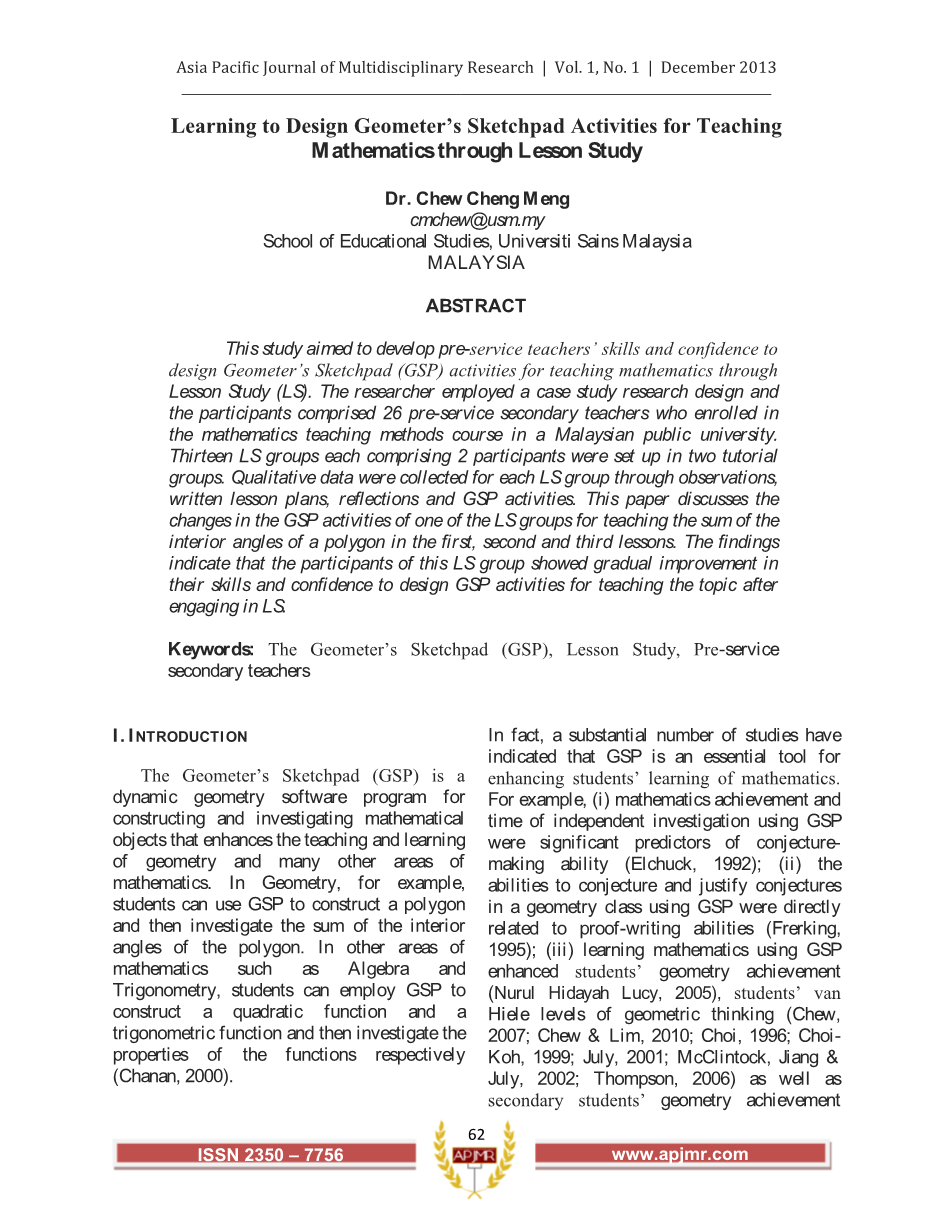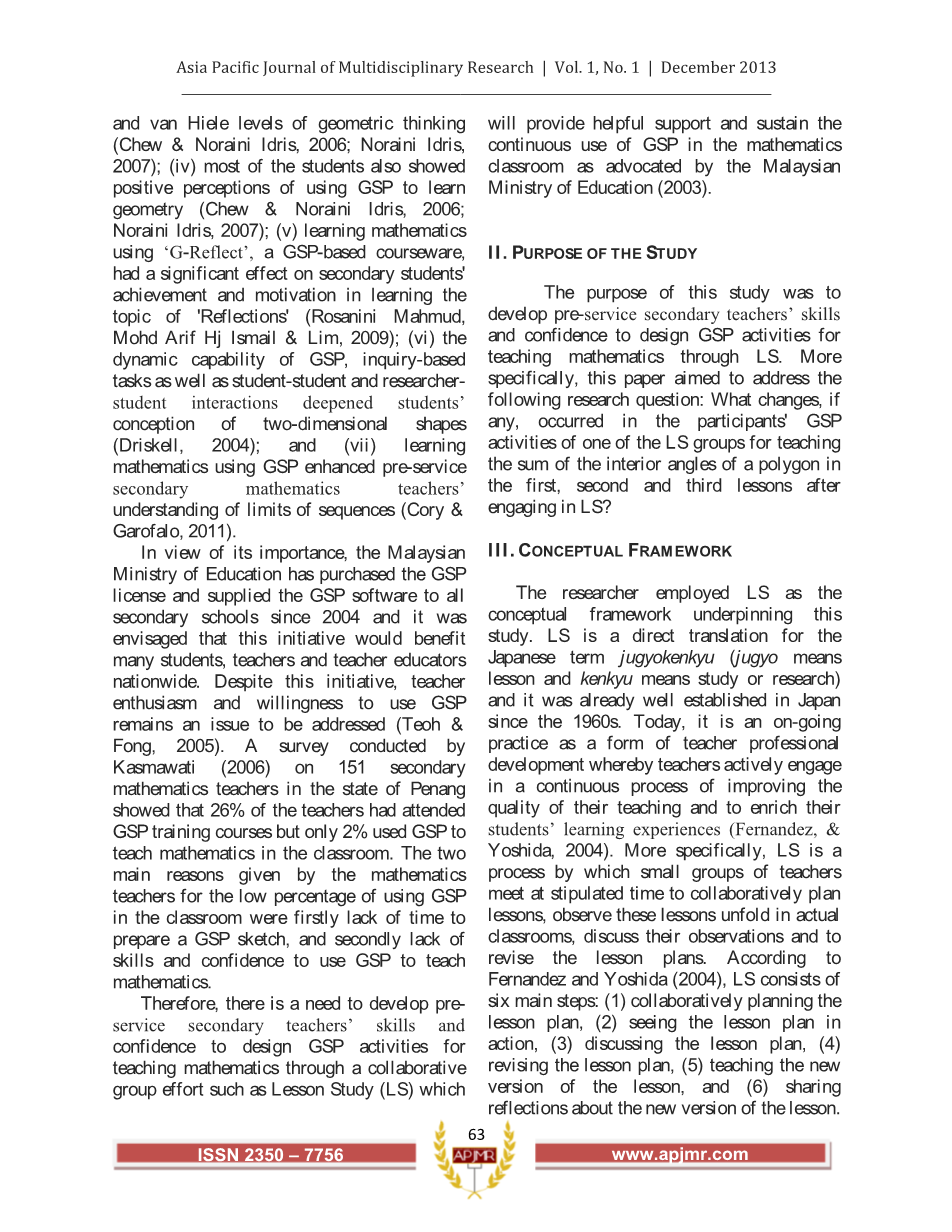本科毕业设计(论文)
外文翻译
Learning to Design Geometerrsquo;s Sketchpad Activities for Teaching Mathematics through Lesson Study
作者:Dr. Chew Cheng Meng
国籍:MALAYSIA
出处:School of Educational Studies, Universiti Sains Malaysia
ABSTRACT
This study aimed to develop pre-service teachersrsquo; skills and confidence to design Geometerrsquo;s Sketchpad (GSP) activities for teaching mathematics through Lesson Study (LS). The researcher employed a case study research design and the participants comprised 26 pre-service secondary teachers who enrolled in the mathematics teaching methods course in a Malaysian public university. Thirteen LS groups each comprising 2 participants were set up in two tutorial groups. Qualitative data were collected for each LS group through observations, written lesson plans, reflections and GSP activities. This paper discusses the changes in the GSP activities of one of the LS groups for teaching the sum of the interior angles of a polygon in the first, second and third lessons. The findings indicate that the participants of this LS group showed gradual improvement in their skills and confidence to design GSP activities for teaching the topic after engaging in LS.
Keywords: The Geometerrsquo;s Sketchpad (GSP), Lesson Study, Pre-service secondary teachers
Introduction
The Geometerrsquo;s Sketchpad (GSP) is a dynamic geometry software program for constructing and investigating mathematical objects that enhances the teaching and learning of geometry and many other areas of mathematics. In Geometry, for example, students can use GSP to construct a polygon and then investigate the sum of the interior angles of the polygon. In other areas of mathematics such as Algebra and Trigonometry, students can employ GSP to construct a quadratic function and a trigonometric function and then investigate the properties of the functions respectively (Chanan, 2000).
In fact, a substantial number of studies have indicated that GSP is an essential tool for enhancing studentsrsquo; learning of mathematics. For example, (i) mathematics achievement and time of independent investigation using GSP were significant predictors of conjecturemaking ability (Elchuck, 1992); (ii) the abilities to conjecture and justify conjectures in a geometry class using GSP were directly related to proof-writing abilities (Frerking, 1995); (iii) learning mathematics using GSP enhanced studentsrsquo; geometry achievement (Nurul Hidayah Lucy, 2005), studentsrsquo; van Hiele levels of geometric thinking (Chew, 2007; Chew amp; Lim, 2010; Choi, 1996; Choi- Koh, 1999; July, 2001; McClintock, Jiang amp; July, 2002; Thompson, 2006) as well as secondary studentsrsquo; geometry achievement and van Hiele levels of geometric thinking (Chew amp; Noraini Idris, 2006; Noraini Idris, 2007); (iv) most of the students also showed positive perceptions of using GSP to learn geometry (Chew amp; Noraini Idris, 2006; Noraini Idris, 2007); (v) learning mathematics using lsquo;G-Reflectrsquo;,a GSP-based courseware, had a significant effect on secondary students achievement and motivation in learning the topic of Reflections (Rosanini Mahmud, Mohd Arif Hj Ismail amp; Lim, 2009); (vi) the dynamic capability of GSP, inquiry-based tasks as well as student-student and researcher- student interactions deepened studentsrsquo; conception of two-dimensional shapes (Driskell, 2004); and (vii) learning mathematics using GSP enhanced pre-service secondary mathematics teachersrsquo; understanding of limits of sequences (Cory amp; Garofalo, 2011).
In view of its importance, the Malaysian Ministry of Education has purchased the GSP license and supplied the GSP software to all secondary schools since 2004 and it was envisaged that this initiative would benefit many students, teachers and teacher educators nationwide. Despite this initiative, teacher enthusiasm and willingness to use GSP remains an issue to be addressed (Teoh amp; Fong, 2005). A survey conducted by Kasmawati (2006) on 151 secondary mathematics teachers in the state of Penang showed that 26% of the teachers had attended GSP training courses but only 2% used GSP to teach mathematics in the classroom. The two main reasons given by the mathematics teachers for the low percentage of using GSP in the classroom were firstly lack of time to prepare a GSP sketch, and secondly lack of skills and confidence to use GSP to teach mathematics.
Therefore, there is a need to develop pre-service secondary teachersrsquo; skills and confidence to design GSP activities for teaching mathematics through a collaborative group effort such as Lesson Study (LS) which will provide helpful support and sustain the continuous use of GSP in the mathematics classroom as advocated by the Malaysian Ministry of Education (2003).
PURPOSE OF THE STUDY
The purpose of this study was to develop pre-service secondary teachersrsquo; skills and confidence to design GSP activities for teaching mathematics through LS. More specifically, this paper aimed to address the following research question: What changes, if any, occurred in the participants GSP activities of one of the LS groups for teaching the sum of the interior angles of a polygon in the first, second and third lessons after engaging in LS.
- CONCEPTUAL FRAMEWORK
The researcher employed LS as the conceptual framework underpinning this study. LS is a direct translation for the Japanese term jugyok^nk^u (^ugyo means lesson and kernk^^u means study or research) and it was already well established i
剩余内容已隐藏,支付完成后下载完整资料


英语原文共 13 页,剩余内容已隐藏,支付完成后下载完整资料
资料编号:[276694],资料为PDF文档或Word文档,PDF文档可免费转换为Word


